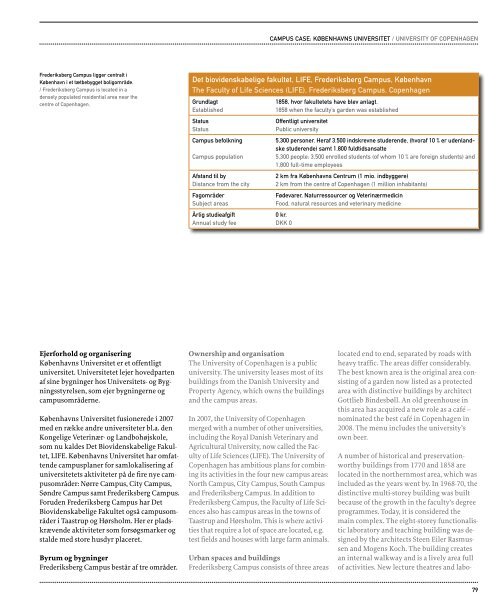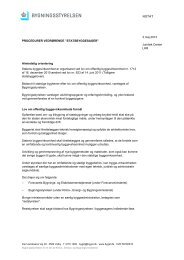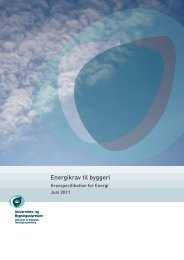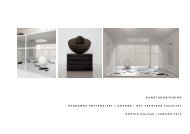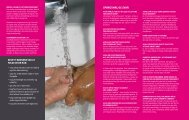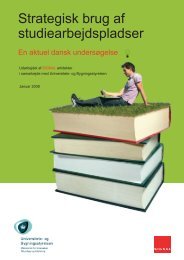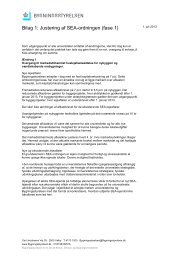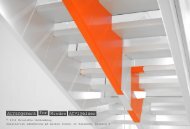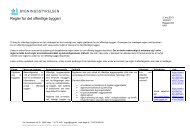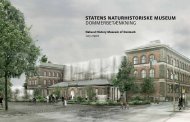Campus og studiemiljø - Bygningsstyrelsen
Campus og studiemiljø - Bygningsstyrelsen
Campus og studiemiljø - Bygningsstyrelsen
You also want an ePaper? Increase the reach of your titles
YUMPU automatically turns print PDFs into web optimized ePapers that Google loves.
Frederiksberg <strong>Campus</strong> ligger centralt i<br />
københavn i et tætbebygget boligområde.<br />
/ Frederiksberg <strong>Campus</strong> is located in a<br />
densely populated residential area near the<br />
centre of Copenhagen.<br />
ejerforhold <strong>og</strong> organisering<br />
Københavns Universitet er et offentligt<br />
universitet. Universitetet lejer hovedparten<br />
af sine bygninger hos Universitets- <strong>og</strong> <strong>Bygningsstyrelsen</strong>,<br />
som ejer bygningerne <strong>og</strong><br />
campusområderne.<br />
Københavns Universitet fusionerede i 2007<br />
med en række andre universiteter bl.a. den<br />
Kongelige Veterinær- <strong>og</strong> Landbohøjskole,<br />
som nu kaldes Det Biovidenskabelige Fakultet,<br />
LIFE. Københavns Universitet har omfattende<br />
campusplaner for samlokalisering af<br />
universitetets aktiviteter på de fire nye campusområder:<br />
Nørre <strong>Campus</strong>, City <strong>Campus</strong>,<br />
Søndre <strong>Campus</strong> samt Frederiksberg <strong>Campus</strong>.<br />
Foruden Frederiksberg <strong>Campus</strong> har Det<br />
Biovidenskabelige Fakultet <strong>og</strong>så campusområder<br />
i Taastrup <strong>og</strong> Hørsholm. Her er pladskrævende<br />
aktiviteter som forsøgsmarker <strong>og</strong><br />
stalde med store husdyr placeret.<br />
Byrum <strong>og</strong> bygninger<br />
Frederiksberg <strong>Campus</strong> består af tre områder.<br />
ownership and organisation<br />
The University of Copenhagen is a public<br />
university. The university leases most of its<br />
buildings from the Danish University and<br />
Property Agency, which owns the buildings<br />
and the campus areas.<br />
In 2007, the University of Copenhagen<br />
merged with a number of other universities,<br />
including the Royal Danish Veterinary and<br />
Agricultural University, now called the Faculty<br />
of Life Sciences (LIFE). The University of<br />
Copenhagen has ambitious plans for combining<br />
its activities in the four new campus areas:<br />
North <strong>Campus</strong>, City <strong>Campus</strong>, South <strong>Campus</strong><br />
and Frederiksberg <strong>Campus</strong>. In addition to<br />
Frederiksberg <strong>Campus</strong>, the Faculty of Life Sciences<br />
also has campus areas in the towns of<br />
Taastrup and Hørsholm. This is where activities<br />
that require a lot of space are located, e.g.<br />
test fields and houses with large farm animals.<br />
urban spaces and buildings<br />
Frederiksberg <strong>Campus</strong> consists of three areas<br />
<strong>Campus</strong> Case: køBenHavns universitet / university oF CopenHagen<br />
det biovidenskabelige fakultet, liFe, Frederiksberg <strong>Campus</strong>, københavn<br />
the Faculty of life sciences (liFe), Frederiksberg <strong>Campus</strong>, Copenhagen<br />
grundlagt<br />
established<br />
status<br />
status<br />
<strong>Campus</strong> befolkning<br />
<strong>Campus</strong> population<br />
afstand til by<br />
distance from the city<br />
Fagområder<br />
subject areas<br />
Årlig studieafgift<br />
annual study fee<br />
1858, hvor fakultetets have blev anlagt.<br />
1858 when the faculty’s garden was established<br />
offentligt universitet<br />
public university<br />
5.300 personer. Heraf 3.500 indskrevne studerende, (hvoraf 10 % er udenlandske<br />
studerende) samt 1.800 fuldtidsansatte<br />
5,300 people: 3,500 enrolled students (of whom 10 % are foreign students) and<br />
1,800 full-time employees<br />
2 km fra københavns Centrum (1 mio. indbyggere)<br />
2 km from the centre of Copenhagen (1 million inhabitants)<br />
Fødevarer, naturressourcer <strong>og</strong> veterinærmedicin<br />
Food, natural resources and veterinary medicine<br />
0 kr.<br />
dkk 0<br />
located end to end, separated by roads with<br />
heavy traffic. The areas differ considerably.<br />
The best known area is the original area consisting<br />
of a garden now listed as a protected<br />
area with distinctive buildings by architect<br />
Gottlieb Bindesbøll. An old greenhouse in<br />
this area has acquired a new role as a café –<br />
nominated the best café in Copenhagen in<br />
2008. The menu includes the university’s<br />
own beer.<br />
A number of historical and preservationworthy<br />
buildings from 1770 and 1858 are<br />
located in the northernmost area, which was<br />
included as the years went by. In 1968-70, the<br />
distinctive multi-storey building was built<br />
because of the growth in the faculty’s degree<br />
pr<strong>og</strong>rammes. Today, it is considered the<br />
main complex. The eight-storey functionalistic<br />
laboratory and teaching building was designed<br />
by the architects Steen Eiler Rasmussen<br />
and M<strong>og</strong>ens Koch. The building creates<br />
an internal walkway and is a lively area full<br />
of activities. New lecture theatres and labo-<br />
79


